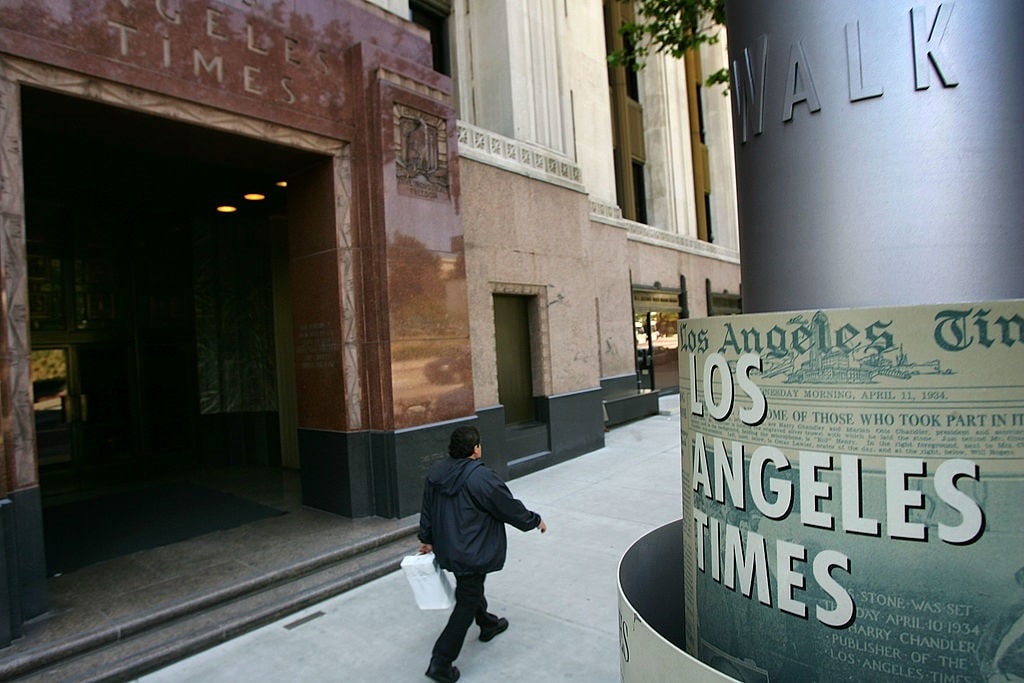It’s both easy and fun to point out examples of progressive contempt for much of America held by the recently laid-off “journalists” of the Los Angeles Times. But there’s a vital quote found among the extensive media self-coverage of their latest big-box financial disaster that spells out just how much trouble an industry built around an exotic woke ideology rather than sound business practice now finds itself in.
“He is willing to continue injecting substantial funds into the LA Times for some years to come, but he is only willing to fund a deficit to a certain level, which the paper has far exceeded.” These are the words attributed to a “person familiar with” the “thinking” of biotech billionaire Patrick Soon-Shiong, owner of the largest daily newspaper in California, according to MarketWatch.

Patrick Soon-Shiong (Photo by Axelle/Bauer-Griffin/FilmMagic)
Soon-Shiong has an estimated net worth of $5.4 billion. The man had a lot of slack to offer a major brand whose name he undoubtedly valued even as its employees were gleefully driving it into the mud. And it still wasn’t enough.
The quote above is reminiscent of a classic remark made by wealthy NFL owner Edward Bennett Williams when he fired famously intense head coach George Allen in the 1970s: “I gave George an unlimited budget – and he exceeded it.”
Big-Box ‘Bloodbath’
“As the prospects for news publishers waned in the past decade, billionaires swooped in to buy some of the country’s most fabled brands,” The New York Times reported January 18. (It should be noted that Mexican billionaire Carlos Slim “swooped” onto the scene to provide a financial lifeline to the struggling Gray Lady in 2009.) “Soon-Shiong … purchased The Los Angeles Times in 2018 for $500 million. Marc Benioff, the founder of the software giant Salesforce, purchased Time magazine with his wife, Lynne, for $190 million in 2018,” the paper notes.
But the cash infusions proved to be no miracle cure for a systemically broken bottom line.

Ann Marie Lipinski (Photo by Aaron Davidson/Getty Images for Eisenhower Fellowships)
“Wealth doesn’t insulate an owner from the serious challenges plaguing many media companies, and it turns out being a billionaire isn’t a predictor for solving those problems,” Ann Marie Lipinski, “curator” of establishment entity the Nieman Foundation for Journalism at Harvard, told The NYT. “We’ve seen a lot of naïve hope attached to these owners, often from employees.”
Reality is now biting with a vengeance.
“Nearly a dozen mainstream media companies are gutting staff and scrambling to rescue their struggling businesses,” Axios reported January 26. “Media cuts were so severe last year that most industry observers weren’t expecting such intense cutbacks in 2024. But an ongoing bloodbath is decimating news outlets nationwide.”
Time laid off 30 employees in January. But it is the tumbling Los Angeles Times that is garnering the lion’s share of attention.
“In the middle of last year, The Times was on track to lose $30 million to $40 million in 2023, according to three people with knowledge of the projections,” The New York Times related. “Last year, the company cut about 74 jobs.”
On January 23, the LA Times let another 115 employees go. That amounts to over 20% of the news staff.
At some point, one might assume a bit of self-reflection would be in order. After all, if a restaurant waters down its food quality and sees nothing but empty tables as a result, it might wonder if it’s time to take stock of the dishes being served.
Does anyone expect such a capability from these self-important journalists hanging by a thread today?
Fear and Loathing in Modern Media
The big-box media at large, and the Los Angeles Times in particular, has spent years openly sacrificing the very believability of their output on the altar of an ever-rigid – and increasingly mean-spirited – politically correct progressive mania.
Inflammatory opinion pieces such as columnist Michael Hiltzik’s January 2022 screed, provocatively titled “Mocking anti-vaxxers’ COVID deaths is ghoulish, yes – but may be necessary,” seemed designed to offend millions of Americans.
Articles presented as news items to readers were nothing more than diatribes in support of an obvious agenda. “Children apologize to their dying elders for spreading COVID-19 as LA County reels,” read the headline to a January 12, 2021, news article. What followed was a monument to hysteria that leaned heavily on public officials from the notoriously leftist Los Angeles government.
Then there was that time in March 2023 when the paper “reported” that white people driving automobiles are “polluting the air breathed by LA’s people of color.” Once again, this is flagrant cultural warfare dressed up as journalism, aiming to fuel anger and divisiveness among the city’s citizenry.
This is how one loses credibility. Yet trapped in an endless cycle of partisan emotionalism, the only contemplation to come out of the dire financial distress will be that of self-pity. “I’m still at a loss of what to say about these layoffs,” Times columnist Erika D. Smith wrote in an X post. “I’m still employed. But this is such a blow to journalism, not just in California but across the US – and at a critical juncture for what’s left of democracy too. Subscribe.”
One of the many negative responses Smith received sums it up well: “Local news is important to democracy only when journalists have integrity. Most do not.”
If multi-billionaire benefactors are not enough to buy back this lost trust, it’s not hard to guess what comes next. Expect the push for direct government funding of news organizations to explode in 2024.




